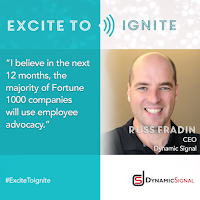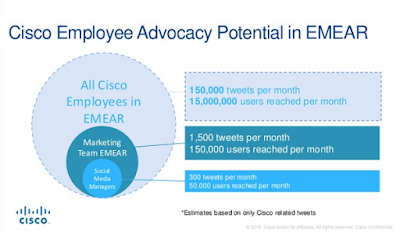Social media "employee empowerment" is catching on in a wide variety of companies.
It helps a brand leverage the social reach of its employees to talk to an audience that can be 10 times larger than the brand’s.
 Social media employee empowerment programs are proving highly successful at brands such as Lenovo, Oracle and Cisco where employees using their own social networks become brand ambassadors.
Social media employee empowerment programs are proving highly successful at brands such as Lenovo, Oracle and Cisco where employees using their own social networks become brand ambassadors.Increased reach and engagement are just two of the often-cited benefits for brands.
I recently became aware of just how widespread employee empowerment is thanks to Stephanie Dobyns who does marketing at Dynamic Signal in San Francisco and who, via a Twitter conversation, pointed out some great examples of employee empowerment going on in various companies.
Her own boss, Russ Fradin, CEO at Dynamic Signal, has predicted that in the next 12 months a majority of top companies will be use employee advocacy (see image).
So, how do companies implement a social media employee empowerment program?
Social media employee empowerment resources:
Inbound Marketing: What Comes After the Tipping Point? - (a Cisco blog post by Dr. Christine Bailey, Marketing Director, EMEA & Russia for Cisco) says five big changes are coming to marketing in the coming year and No. 5 is: "Employee advocacy will fuel marketing.”
From Oracle: 4 Steps To Create A Culture of Employee Advocacy - looks at four key areas that companies and their employees need to learn to trust each other.
Leveraging Employees through Social Media with Charlene Li (email address required to view) - In this 55-minute video of a Dynamic Signal webinar Charlene Li, founder of the Altimeter Group, reports on research showing that a vast majority of companies are going through digital marketing transformations and that employee advocacy through social media is a key part of that change.
Lenovo created an internal social network to improve employee engagement - talks about how the China-based computer manufacturer got a huge lift in its marketing efforts by encouraging a relatively small proportion of employees to first share information on an internal social network before sharing elsewhere. It also reports this interesting detail: "Studies have shown that employees who are encouraged to share stories about the company on social media tend to stay with the company longer and are more loyal."
Employee Advocacy vs Social Selling & How to Drive Revenue Using Both - looks at the similarities of employee advocacy and social selling. Author Anna Stevens, Digital Marketing Manager at Recall, says brands can create long-lasting circles of trust. "Here's how. Your employees trust you >> Their social networks trust them >> So, your company's message, products, and events authentically reach new people."
5 Common Problems with Employee Advocacy - is an Oracle blog post that identifies some typical objections/hurdles to employee advocacy programs and offers solutions.
So, is social media employee empowerment for you and your brand? I’d love to hear other examples.
Related posts
Employee empowerment drives massive social media results for brand
2015: The Year of SM #EmployeeEmpowerment and How to Create a Successful Program







